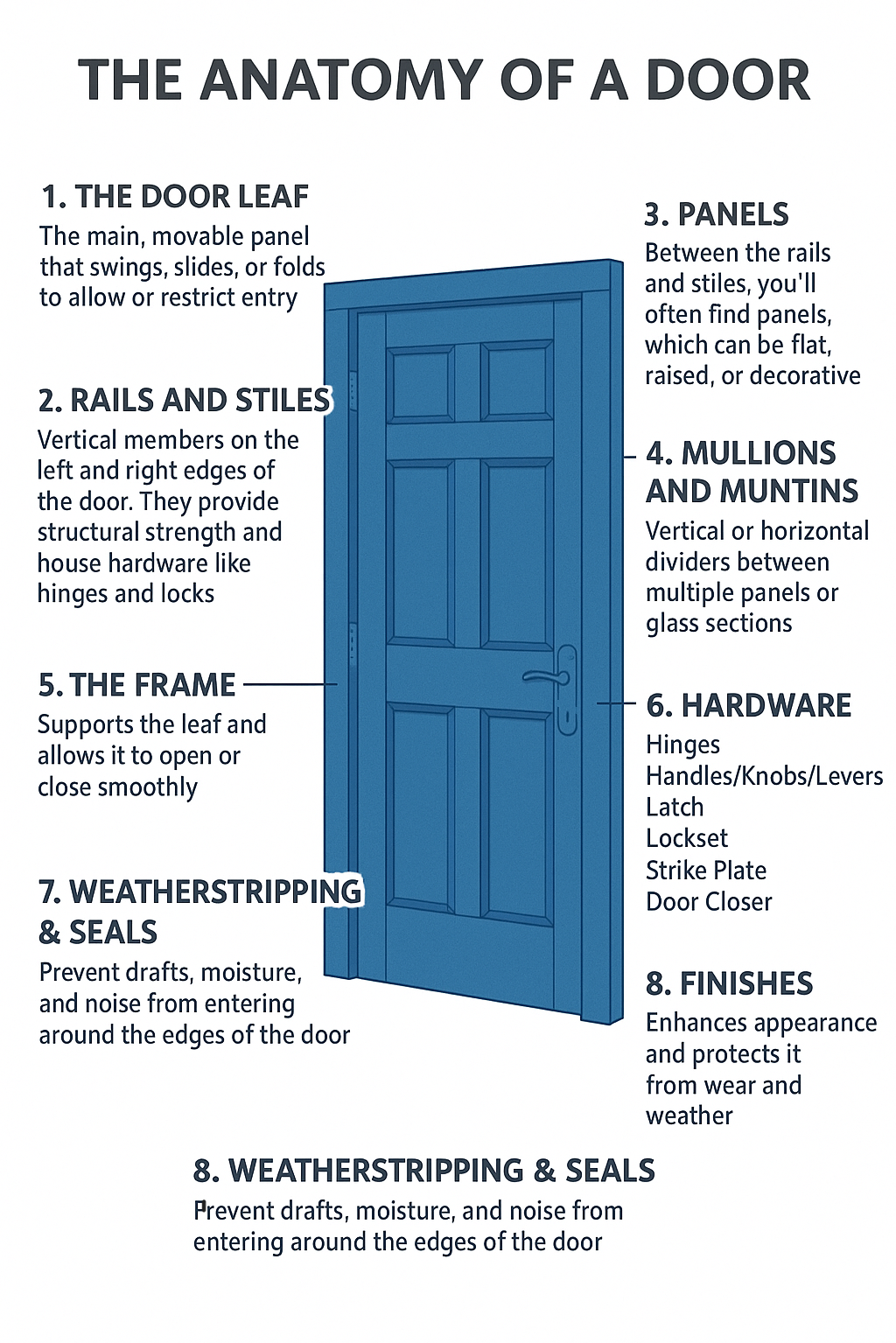Article
Anatomy of a Door
Your Guide to Door Parts

A door is far more than just a barrier between spaces—it’s a carefully designed structure that blends function, security, and style. While it may seem like a single, simple piece, a door is actually made up of multiple components working together to provide strength, ease of use, and visual appeal. From the solid framework that supports it, to the panels, rails, and stiles that shape its design, and the hardware that ensures smooth operation, each part of a door plays a vital role. Understanding the anatomy of a door not only helps when repairing or replacing one, but also empowers homeowners, builders, and design enthusiasts to make informed choices that enhance both the practicality and beauty of their spaces.
🔧 Basic Terms
- The Leaf: The leaf is the main, movable panel that swings, slides, or folds to allow or restrict entry.
-
Materials: Wood, steel, fiberglass, glass, or composite materials.
-
Styles: Solid core, hollow core, paneled, flush, or glazed.
-
- Rails and Stiles: In traditional framed doors, the leaf is made up of:
-
Stiles – Vertical members on the left and right edges. They provide structural strength and house hardware like hinges and locks.
-
Rails – Horizontal members that connect the stiles.
-
Top Rail – The uppermost horizontal piece.
-
Bottom Rail – The lowermost horizontal piece, often thicker for strength.
-
Lock Rail – Positioned at handle height, housing the latch or lock mechanism.
-
-
- Panels: Between the rails and stiles, you’ll often find panels, which can be flat, raised, or decorative. In glass doors, these are replaced with lites—glass inserts.
- Mullions and Muntins: These terms often confuse people:
-
Mullions – Vertical or horizontal dividers between multiple panels or glass sections.
-
Muntins – Smaller strips that divide a single glass pane into smaller segments, common in traditional windowed doors.
-
- The Frame: The frame supports the leaf and allows it to open or close smoothly. It includes:
-
Head (Head Jamb) – The horizontal top part of the frame.
-
Side Jambs – The vertical members on either side.
-
Sill (Threshold) – The bottom portion where the door meets the floor; it can be raised, sloped, or flush.
-
- Hardware: The hardware is the “working” part of the door, controlling movement, security, and style.
-
Hinges – Allow the door to pivot open and closed.
-
Handles / Knobs / Levers – Provide a grip for operation.
-
Latch – Keeps the door closed without locking.
-
Lockset – Adds security with a key or electronic access.
-
Strike Plate – Mounted on the frame where the latch engages.
-
Door Closer – Controls the speed of closure (often used in commercial doors).
-
- Weatherstripping & Seals: These components prevent drafts, moisture, and noise from entering around the edges. Common materials include rubber, foam, or silicone.
- Finishes: A finish not only enhances appearance but also protects it from wear and weather. Options include paint, stain, clear varnish, or factory-applied laminates.
Why Knowing Matters
Whether you’re replacing hardware, diagnosing a squeak, upgrading for better insulation, or designing a custom entryway, understanding each part of a door allows you to communicate clearly with suppliers and contractors—and make better buying decisions.
In short: A door isn’t just a flat slab; it’s a combination of engineered parts working together for function, security, and style. The next time you open one, you might see it less as a barrier—and more as a finely tuned mechanism. View our custom door gallery here.
